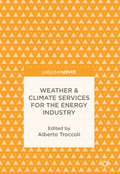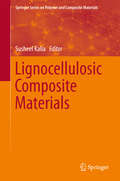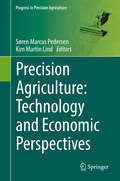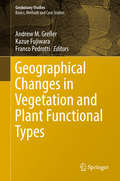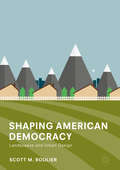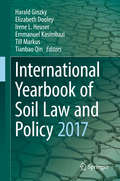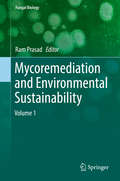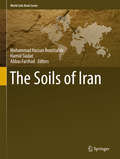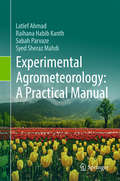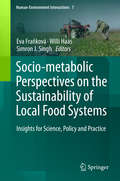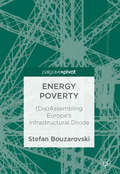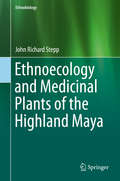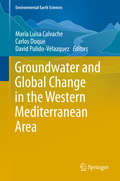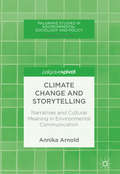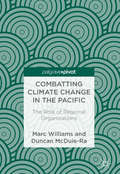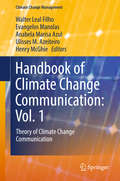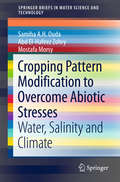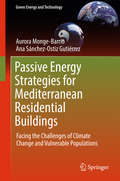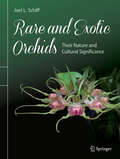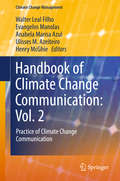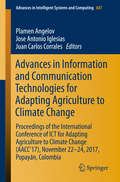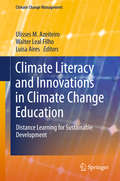- Table View
- List View
Weather & Climate Services for the Energy Industry
by Alberto TroccoliThis open access book showcases the burgeoning area of applied research at the intersection between weather and climate science and the energy industry. It illustrates how better communication between science and industry can help both sides. By opening a dialogue, scientists can understand the broader context for their work and the energy industry is able to keep track of and implement the latest scientific advances for more efficient and sustainable energy systems. Weather & Climate Services for the Energy Industry considers the lessons learned in establishing an ongoing discussion between the energy industry and the meteorological community and how its principles and practises can be applied elsewhere. This book will be a useful guiding resource for research and early career practitioners concerned with the energy industry and the new field of research known as energy meteorology.
Lignocellulosic Composite Materials (Springer Series on Polymer and Composite Materials)
by Susheel KaliaThis book comprehensively summarizes important aspects of research in the active field of lignocellulosic (polymer) composites, including polymer materials from or containing cellulose, hemicellulose and lignin. It describes how these materials can be produced from forest products and natural fibers from sources such as jute, flax, sisal, and many more, and even from agricultural residues (like wheat straw, corn stover, or sugarcane bagasse). In times of high demand for renewable green materials, lignocellulosic materials from organic matter produced by trees, shrubs and agricultural crops present a highly attractive feedstock.The international authors explain different treatment and fabrication methods for the production of lignocellulosic materials. Other chapters address the properties of these green materials or illustrate specific applications, ranging from food packaging and household products to adsorbents and even conductive polymer composites. In this way, this book offers a broad and comprehensive overview over the entire field of lignocellulosic composite materials.
Precision Agriculture: Technology and Economic Perspectives (Progress in Precision Agriculture)
by Søren Marcus Pedersen Kim Martin LindThis book presents cases from different countries with a main focus on the perspectives of using precision farming in Europe. Divided into 12 chapters it addresses some of the most recent developments and aspects of precision farming. The intention of this book is to provide an overview of some of the most promising technologies with precision agriculture from an economic point of view. Each chapter has been put together so that it can be read individually should the reader wish to focus on one particular topic. Precision Farming as a farm technology benefits from large-scale advantages due to relatively high investment costs and is primarily adopted on farms with medium to large field areas.
Geographical Changes in Vegetation and Plant Functional Types (Geobotany Studies)
by Andrew M. Greller Kazue Fujiwara Franco PedrottiThis book presents studies on current vegetation topics, from polar to tropical regions. It is a festschrift to mark the 70th birthday of Prof. Elgene O. Box, who has studied vegetation all over the world, both through fieldwork and modeling. It reflects a number of his interests, including basic ecological plant forms (cf ‘plant functional types’), temperate-zone forests, and evergreen versus seasonal patterns. Section 1 discusses the concept of vegetation series, while Section 2 has two global-scale chapters on plant functional traits and whether they are related more to climate or phylogeny. Section 3 has nine chapters focusing on vegetation history, regional vegetation, and how these have influenced current species organizations and distributions. Regions treated include Russia, China, the USA, Mexico and Mediterranean areas. Lastly, Section 4 addresses aspects of vegetation change and plant ecology. Every chapter in this unique book offers original ideas on the topic of vegetation, as the authors are assembled from a world-wide population of leading vegetational ecologists, whose interests range from local communities to global theoretical questions.
Shaping American Democracy: Landscapes and Urban Design
by Scott M. RoulierThis book argues that the design of built spaces influences civic attitudes, including prospects for social equality and integration, in America. Key American architects and planners—including Frederick Law Olmsted, Frank Lloyd Wright, Robert Moses, and the New Urbanists—not only articulated unique visions of democracy in their extensive writings, but also instantiated those ideas in physical form. Using criteria such as the formation of social capital, support for human capabilities, and environmental sustainability, the book argues that the designs most closely associated with a communally-inflected version of democracy, such as Olmsted's public parks or various New Urbanist projects, create conditions more favorable to human flourishing and more consistent with a democratic society than those that are individualistic in their orientation, such as urban modernism or most suburban forms.
International Yearbook of Soil Law and Policy 2017 (International Yearbook of Soil Law and Policy #2017)
by Harald Ginzky Elizabeth Dooley Irene L. Heuser Emmanuel Kasimbazi Till Markus Tianbao QinThis book presents an important discussion on soil and sustainable agriculture from a range of perspectives, addressing key topics such as sustainable intensification, the FAO Voluntary Guidelines, and the crucial role of appropriate tenure rights. This second volume of the International Yearbook of Soil Law and Policy is divided into four parts, the first of which deals with several aspects of the theme “soil and sustainable agriculture.” In turn, the second part covers recent international developments, the third part presents regional and national reports, and the fourth discusses cross-cutting issues. Given the range of key topics covered, the book offers an indispensable tool for all academics, legislators and policymakers working in this field. The “International Yearbook of Soil Law and Policy” is a book series that discusses central questions in law and politics with regard to the protection and sustainable management of soil and land – at the international, national and regional level. The Chapter "The Use of Property Law Tools for Soil Protection" by Jessica Owley is available open access under a CC BY 4.0 license at link.springer.com.
Mycoremediation and Environmental Sustainability: Volume 1 (Fungal Biology)
by Ram PrasadBioremediation is the use of microorganisms' metabolism to degrade waste contaminants (sewage, domestic, and industrial effluents) into non-toxic or less toxic materials by natural biological processes. Remediation through fungi—or mycoremediation—has multifarious possibilities in applied remediation engineering and the future of environmental sustainability. Fungi have the biochemical and ecological capability to degrade environmental organic chemicals and to decrease the risk associated with metals, semi-metals, noble metals, and radionuclides, either by chemical modification or by manipulating chemical bioavailability. Additionally, the capability of these fungi to form extended mycelia networks, the low specificity of their catabolic enzymes, and their using pollutants as a growth substrate make these fungi well suited for bioremediation processes. Their mycelia exhibit the robustness of adapting to highly limiting environmental conditions often experienced in the presence of persistent pollutants, which makes them more useful compared to other microbes. However, despite dominating the living biomass in soil and being abundant in aquatic ecosystems, fungi have not been exploited for the bioremediation of such environments. This book covers the various types of fungi and associated fungal processes used to clean up waste and wastewaters in contaminated environments and discusses future potential applications.
The Soils of Iran (World Soils Book Series)
by Mohammad Hassan Roozitalab Hamid Siadat Abbas FarshadThis unique book addresses Iran’s extremely rich soil diversity and resources, which have developed under various climatic conditions ranging from dry to humid conditions. Featuring contributions by a group of respected experts on Iranian soils and agriculture, it provides comprehensive information on the management approaches needed for sustainable soil utilization and conservation under such conditions, and the attendant challenges. As such, it offers a valuable resource for anyone interested in soils and agriculture in Iran, but also in other Middle East and North African countries with similar climatic conditions. The book contains 14 chapters which illustrate the long history of indigenous knowledge and soil research, climate, geology and geomorphology, vegetation cover, soil forming factors and processes, major soils, properties and their classification. Furthermore, it presents past climate change and paleosols, agroecological zones, soil fertility, soil biology and biotechnology, human induced land degradation and “soil management in space and time”. In the end, major challenges facing the soil resources of the country are defined and recommendations are made to face the future challenges.
Experimental Agrometeorology: A Practical Manual
by Latief Ahmad Raihana Habib Kanth Sabah Parvaze Syed Sheraz MahdiThe book is a practical manual which has been created to support the syllabus of agro-meteorology courses specifically designed for graduate and post-graduate students. The topics covered in the manual include working with meteorological instruments for measurement of various meteorological parameters like temperature, humidity, sunshine hours, precipitation, etc. Separate chapters have been included for computation of growing degree days, agro-climatic zones, crop modelling and agro-advisory services. The book will have great appeal to students of agriculture, horticulture, and forestry.
Socio-Metabolic Perspectives on the Sustainability of Local Food Systems: Insights for Science, Policy and Practice (Human-Environment Interactions #7)
by Eva Fraňková Willi Haas Simron J. SinghThis book delves into diverse local food systems and critically assesses their ecological and societal benefits and trade-offs, their limits and opportunities for improving sustainability of food production, and framework conditions which either hinder or promote their development. More and more people with gradually meat heavier diets will demand growth in food production, whilst our increasingly industrialized and globalized agri-food system has already caused serious sustainability problems in the past. This calls for a change in the way we produce, distribute and consume food. A re-emerging debate on food security and food sovereignty seems to support this quest. But what are the promising alternatives to mainstream developments? Such a discussion regarding sustainability of local food systems requires a sound systemic understanding and thus invites a socio-metabolic reading of local cases by analyzing the nexus between material and energy flows as well as land and time use. This approach is needed to complement the so far mostly qualitatively-based local food studies. Applying socio-metabolic approaches to local food systems fosters a better understanding of promises and pitfalls for sustainable pathways in the future.
Energy Poverty: (Dis)Assembling Europe's Infrastructural Divide
by Stefan BouzarovskiThis open access book aims to consolidate and advance debates on European and global energy poverty by exploring the political and infrastructural drivers and implications of the condition across a variety of spatial scales. It highlights the need for a geographical conceptualization of the different ways in which household-level energy deprivation both influences and is contingent upon disparities occurring at a wider range of spatial scales. There is a strong focus on the relationships among energy transformation, institutional change and place-based factors in determining the nature and location of energy-related injustices. The book also explores how patterns and structures of energy poverty have changed over time, as evidenced by some of the common measures used to describe the condition. In part, this means investigating the makeup of energy poor demographics across various social and spatial cleavages. More broadly, it also argues that energy sector reconfigurations are both reflected in and shaped by various domains of social and political organization, especially in terms of creating poverty-relevant outcomes.
Energy Poverty: (Dis)Assembling Europe's Infrastructural Divide
by Stefan BouzarovskiThis open access book aims to consolidate and advance debates on European and global energy poverty by exploring the political and infrastructural drivers and implications of the condition across a variety of spatial scales. It highlights the need for a geographical conceptualization of the different ways in which household-level energy deprivation both influences and is contingent upon disparities occurring at a wider range of spatial scales. There is a strong focus on the relationships among energy transformation, institutional change and place-based factors in determining the nature and location of energy-related injustices. The book also explores how patterns and structures of energy poverty have changed over time, as evidenced by some of the common measures used to describe the condition. In part, this means investigating the makeup of energy poor demographics across various social and spatial cleavages. More broadly, it also argues that energy sector reconfigurations are both reflected in and shaped by various domains of social and political organization, especially in terms of creating poverty-relevant outcomes.
Ethnoecology and Medicinal Plants of the Highland Maya (Ethnobiology Ser.)
by John Richard SteppPlants play a central role in human existence. Medicinal plants, in particular, have allowed for the continued survival of the human species. This book, based on over a decade of research in Southern Mexico with the Highland Maya, explores the relationship between medicinal plants, traditional ecological knowledge and the environment. The biodiversity of the region remains among the highest in the world, comprising more than 9000 plant species. Over 1600 employed for medicinal uses and knowledge for approximately 600 species is widespread. Medicinal plants play an overwhelmingly primary role in the daily health care of the Highland Maya. Three principal objectives are addressed: 1) identifying which medicinal plants are used; 2) determining the role of environmental variation on use and selection of medicinal plants; and 3) identifying which habitats are preferred for medicinal plant procurement. Findings demonstrate the overwhelming importance of human modified environments for medicinal plants. Explanations are presented from human ecology and biochemical ecology. Implications for conservation, health and the environment are discussed.
Groundwater and Global Change in the Western Mediterranean Area (Environmental Earth Sciences)
by Maria Luisa Calvache Carlos Duque David Pulido-VelazquezThis book is a compilation of papers examining the impacts of global change (GC) on water resources systems. Mainly focusing on groundwater resources in Western Mediterranean countries, it shows that this topic is one of the most important challenges facing society. The papers explore developments in both Southern Europe and North Africa, where major impacts on the sustainability, quantity, quality, and management of water resources are expected to emerge. Although most global change publications focus on surface water, the number of research papers addressing global change and groundwater has grown rapidly in recent years. Continuing that welcome trend, this book gathers the main findings presented at the “Congress on Groundwater and Global Change in the Western Mediterranean” (Granada, Spain, November 6–9, 2017), which brought together researchers and technicians interested in groundwater issues affecting this geographic area.
Climate Change and Storytelling: Narratives and Cultural Meaning in Environmental Communication
by Annika ArnoldClimate change is as much a cultural phenomenon as it is a natural one. This book is about those cultural patterns that surround our perception of the environmental crisis and which are embodied in the narratives told by climate change advocates. It investigates the themes and motifs in those narratives through the use of narrative theory and cultural sociology.Developing a framework for cultural narrative analysis, Climate Change and Storytelling draws on qualitative interviews with stakeholders, activists and politicians in the USA and Germany to identify motifs and the relationships between heroes, villains and victims, as told by the messengers of the narrative.This book will provide academics and practitioners with insights into the structure of climate change communication among climate advocates and the cultural fabric that informs it.
Climate Change and Storytelling: Narratives and Cultural Meaning in Environmental Communication
by Annika ArnoldClimate change is as much a cultural phenomenon as it is a natural one. This book is about those cultural patterns that surround our perception of the environmental crisis and which are embodied in the narratives told by climate change advocates. It investigates the themes and motifs in those narratives through the use of narrative theory and cultural sociology.Developing a framework for cultural narrative analysis, Climate Change and Storytelling draws on qualitative interviews with stakeholders, activists and politicians in the USA and Germany to identify motifs and the relationships between heroes, villains and victims, as told by the messengers of the narrative.This book will provide academics and practitioners with insights into the structure of climate change communication among climate advocates and the cultural fabric that informs it.
Combatting Climate Change in the Pacific: The Role of Regional Organizations
by Marc Williams Duncan McDuie-RaThis book analyses the regional complexes of climate security in the Pacific. Pacific Island States and Territories (PICTs) have long been cast as the frontline of climate change and placed within the grand architecture of global climate governance. The region provides compelling new insights into the ways climate change is constructed, governed, and shaped by (and in turn shapes), regional and global climate politics. By focusing on climate security as it is constructed in the Pacific and how this concept mobilises resources and shapes the implementation of climate finance, the book provides an up-to-date account of the way regional organizations in the Pacific have contributed to the search for solutions to the problem of climate insecurity. In the context of the United Nations Climate Change Conference (COP21) in Paris in 2015, the focus of this book on regional governance offers a concise and innovative account of climate politics in the prevailing global context and one with implications for the study of climate security in other regions, particularly in the developing world.
Combatting Climate Change in the Pacific: The Role of Regional Organizations
by Marc Williams Duncan McDuie-RaThis book analyses the regional complexes of climate security in the Pacific. Pacific Island States and Territories (PICTs) have long been cast as the frontline of climate change and placed within the grand architecture of global climate governance. The region provides compelling new insights into the ways climate change is constructed, governed, and shaped by (and in turn shapes), regional and global climate politics. By focusing on climate security as it is constructed in the Pacific and how this concept mobilises resources and shapes the implementation of climate finance, the book provides an up-to-date account of the way regional organizations in the Pacific have contributed to the search for solutions to the problem of climate insecurity. In the context of the United Nations Climate Change Conference (COP21) in Paris in 2015, the focus of this book on regional governance offers a concise and innovative account of climate politics in the prevailing global context and one with implications for the study of climate security in other regions, particularly in the developing world.
Handbook of Climate Change Communication: Theory of Climate Change Communication (Climate Change Management)
by Walter Leal Filho Evangelos Manolas Anabela Marisa Azul Ulisses M. Azeiteiro Henry McGhieThis comprehensive handbook provides a unique overview of the theory, methodologies and best practices in climate change communication from around the world. It fosters the exchange of information, ideas and experience gained in the execution of successful projects and initiatives, and discusses novel methodological approaches aimed at promoting a better understanding of climate change adaptation. Addressing a gap in the literature on climate change communication and pursuing an integrated approach, the handbook documents and disseminates the wealth of experience currently available in this field. Volume 1 of the handbook provides a unique description of the theoretical basis and of some of the key facts and phenomena which help in achieving a better understanding of the basis of climate change communication, providing an essential basis for successful initiatives in this complex field.
Cropping Pattern Modification to Overcome Abiotic Stresses: Water, Salinity and Climate (SpringerBriefs in Water Science and Technology)
by Samiha A. Ouda Abd El-Hafeez Zohry Mostafa MorsyThis book provides state-of-the art analysis, never done before in Egypt, on agro-climatic zones level. This study deals with how the national cropping pattern can be modified to overcome abiotic stresses, such as water scarcity, induced salinity and climate change to reduce their negative effects on food production. To this end, different cropping patterns are suggested. This study can be a framework for other developing countries to be used in quantifying and filling the gap in their knowledge about practices that can help in increasing their food security through increasing food production. Furthermore, the study is useful for policy makers to help them in their future plans and policies.
Passive Energy Strategies for Mediterranean Residential Buildings: Facing the Challenges of Climate Change and Vulnerable Populations (Green Energy and Technology)
by Aurora Monge-Barrio Ana Sánchez-Ostiz GutiérrezThis book presents an approach to energy-efficient building design, which takes into account the most important challenges in climate change mitigation and adaptation in Southern Europe. It outlines a specific approach related to residential buildings and their intergenerational and vulnerable occupants, such as ageing population and users in fuel poverty. It also focuses on the use of passive energy measures throughout the year, and on pursuing a realistic and affordable approach to the efficient rehabilitation of resilient residential buildings.In addition, the book presents case studies that include surveys, monitoring, and simulation of residential buildings in Spain and other Southern European representative locations, in order to go further on the study of this challenging topic.
Rare and Exotic Orchids: Their Nature and Cultural Significance
by Joel L. SchiffComprising some 28,000 different species, orchids are by far the largest flowering plant family on Earth. Every year, new species are being uncovered in the wild or created by humans, and so this number has only continued to blossom. This book is intended for those who wish to learn about the multifaceted nature of this amazing plant. It covers many different aspects of orchid study, from its cultural history to its evolutionary development and from its first discoveries to ongoing scientific research. No matter your specialty or level of orchid expertise, you can find in this book new and fascinating facts and stories that will make you gasp, laugh, and read on. Through the many exotic and beautiful pictures permeating these pages, you will come to know something of the infinite diversity of this plant family and at last learn why so many orchid growers and fanatics have embarked on this same endless path.“I was smitten with this book after reading the very first chapter on the history of Orchids...There are plenty of interesting facts to charm your orchid friends and impress even the most studied researcher… All in all a fabulous read that is well illustrated and with a reference section the likes of which I have never seen before with its vast and varied appendices on a slew of subjects. If you are looking for a book that is engaging and educational with lots of good humor thrown in, then this book is for you. I know that I will treasure my copy for years to come.” -- Laura Newton, American Orchid Society Awards Registrar and Accredited Judge, ORCHIDS Magazine (May, 2018)"Joel L. Schiff brings to life not just the science surrounding orchids, but the human process of recognizing, cataloging, and appreciating them...It's this approach, combined with lovely close-up color photos throughout, which makes Rare and Exotic Orchids a recommendation not just for professionals or botany libraries, but for general-interest readers who will enjoy a highly accessible study that invites an in-depth interest in orchids and their importance to human affairs."-- Diane Donovan’s Pick of the Month (April, 2018)
Handbook of Climate Change Communication: Practice of Climate Change Communication (Climate Change Management)
by Walter Leal Filho Evangelos Manolas Anabela Marisa Azul Ulisses M. Azeiteiro Henry McGhieThis comprehensive handbook provides a unique overview of the theory, methodologies and best practices in climate change communication from around the world. It fosters the exchange of information, ideas and experience gained in the execution of successful projects and initiatives, and discusses novel methodological approaches aimed at promoting a better understanding of climate change adaptation. Addressing a gap in the literature on climate change communication and pursuing an integrated approach, the handbook documents and disseminates the wealth of experience currently available in this field. Volume 2 of the handbook provides a unique description of the theoretical basis and of some of the key facts and phenomena which help in achieving a better understanding of the basis of climate change communication, providing an essential basis for successful initiatives in this complex field.
Advances in Information and Communication Technologies for Adapting Agriculture to Climate Change: Proceedings of the International Conference of ICT for Adapting Agriculture to Climate Change (AACC'17), November 22-24, 2017, Popayán, Colombia (Advances in Intelligent Systems and Computing #687)
by Plamen Angelov Jose Antonio Iglesias Juan Carlos CorralesThis book presents novel communication technology solutions to address the effects of climate change and climate variability on agriculture, with a particular focus on those that increase agricultural production. It discusses decision support and early warning systems for agriculture; information technology (IT) supporting sustainable water management and land cover dynamics; predictive of crop production models; and software applications for reducing the effects of diseases and pests on crops. Further topics include the real-time monitoring of weather conditions and water quality, as well as food security issues. Featuring the proceedings of the International Conference of ICT for Adapting Agriculture to Climate Change (AACC’17), held on November 22–24, 2017, in Popayán, Colombia, the book represents a timely report and a source of new ideas and solutions for both researchers and practitioners active in the agricultural sector around the globe.
Climate Literacy and Innovations in Climate Change Education: Distance Learning for Sustainable Development (Climate Change Management)
by Ulisses M. Azeiteiro Walter Leal Filho Luísa AiresThis book addresses the links between climate change and the threats it poses to sustainable development, from a distance education perspective. Discussing current trends and challenges in sustainable development education, climate literacy and innovations in climate change education, it contributes to the global debate on the implementation of education for sustainability. It also assesses the role that e-learning can play in this process, addressing pedagogical concepts as well as the wide range of technological options now available.
